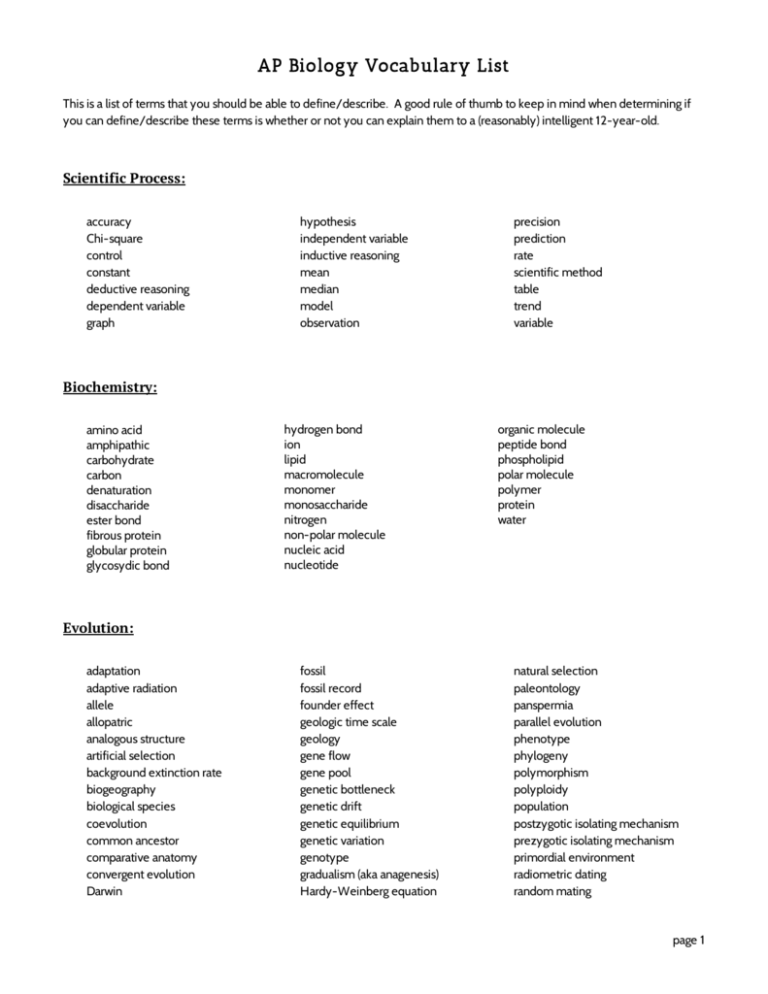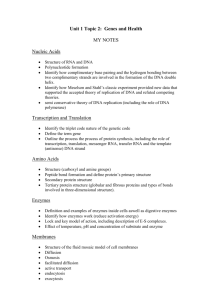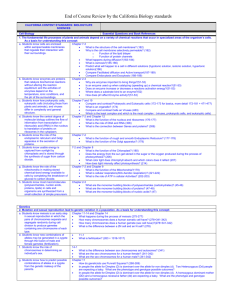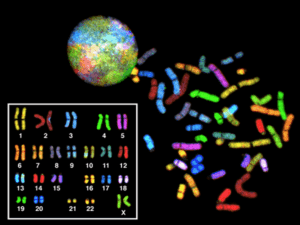AP Biology Vocabulary List
advertisement

AP Biology Vocabulary List This is a list of terms that you should be able to define/describe. A good rule of thumb to keep in mind when determining if you can define/describe these terms is whether or not you can explain them to a (reasonably) intelligent 12-year-old. Scientific Process: accuracy Chi-square control constant deductive reasoning dependent variable graph hypothesis independent variable inductive reasoning mean median model observation precision prediction rate scientific method table trend variable Biochemistry: amino acid amphipathic carbohydrate carbon denaturation disaccharide ester bond fibrous protein globular protein glycosydic bond hydrogen bond ion lipid macromolecule monomer monosaccharide nitrogen non-polar molecule nucleic acid nucleotide organic molecule peptide bond phospholipid polar molecule polymer protein water Evolution: adaptation adaptive radiation allele allopatric analogous structure artificial selection background extinction rate biogeography biological species coevolution common ancestor comparative anatomy convergent evolution Darwin fossil fossil record founder effect geologic time scale geology gene flow gene pool genetic bottleneck genetic drift genetic equilibrium genetic variation genotype gradualism (aka anagenesis) Hardy-Weinberg equation natural selection paleontology panspermia parallel evolution phenotype phylogeny polymorphism polyploidy population postzygotic isolating mechanism prezygotic isolating mechanism primordial environment radiometric dating random mating page 1 differential survival directional selection disruptive selection divergent evolution (aka cladogenesis endosymbiosis epoch evo-devo evolution evolutionary fitness extinction fixation (of alleles) homologous structures homology hybrid Last Universal Common Ancestor mass extinction migration Miller-Urey experiments modern synthesis molecular clock mutation relative dating reproductive isolation RNA world rock strata speciation species stromatolite sympatric transitional fossil vestigial organ Classification & Biological Diversity: Archaea Bacteria binomial nomenclature cladistics cladogram class distinguishing feature Eukarya family genus kingdom monophyletic order paraphyletic phylogenetic tree phylogeny phylum polyphyletic shared derived characteristic shared ancestral characteristic species taxon glycolipid glycoprotein Golgi apparatus G-protein linked receptor hormone hypertonic hypotonic ion pump isotonic ligand light microscope lysosome magnification membrane mitochondrion necrosis nuclear envelope nuclear pore phospholipid phosphorylation cascade pinocytosis plasma membrane plasmolysis prokaryotic cell protein kinase quorum sensing receptor resolution ribosome rough ER second messenger selectively permeable signal cascade signal transduction signal transduction pathway smooth ER Cells: active transport amphipathic apoptosis aquaporin carrier protein cell wall centrioles channel protein chloroplast communication cyclic AMP (cAMP) concentration gradient cytoplasm cytoskeleton diffusion electron microscope endocytosis endoplasmic reticulum page 2 exocytosis eukaryotic cell facilitated diffusion flagella fluid mosaic model nucleus organelles osmosis passive transport phagocytosis surface area:volume ratio transmembrane protein turgor vacuole Cell Division: anaphase cancer cell cycle cellular differentiation cell division centrioles chromosome crossing over crossover frequency cyclin-dependent kinase cytokinesis differentiation diploid (2N) DNA replication fertilization gamete haploid (1N) homologous chromosomes independent assortment interphase maternal chromosome meiosis metaphase mitosis nuclear division p53 paternal chromosome potency prophase recombination sex chromosome somatic cell specialized cell synapsis telophase genetic code genetic engineering genetic transplantation helicase homeotic genes HOX genes hydrogen bonding inducible genes introns lac operon lagging strand leading strand micro RNA (miRNA) morphogenesis morphogens mutation nucleic acids nucleotides Okazaki fragments polymerase chain reaction protein regulatory sequence replication fork repressor restriction enzyme reverse transcriptase RNA (mRNA, rRNA, tRNA RNAi small interfering RNA (siRNA) small regulatory RNA start codon/stop codon template strand transcription transcription factors transgenic organism translation Molecular Genetics: activator amino acids anticodon base-pairing rules cell differentiation constituitive gene coding strand codon DNA DNA ligase DNA polymerase DNA replication embryonic induction exons gel electrophoresis gene expression gene induction gene repression page 3 Mendelian Genetics: allele autosome back cross cline codominance continuous variation cross dihybrid cross discontinuous variation dominant F1/F2 Generation genetic counseling genomic imprinting genotype heterozygous homozygous incomplete dominance independent assortment lethal allele linkage monohybrid cross multiple alleles non-disjunction non-nuclear inheritance pedigree analyisis phenotype phenotypic plasticity polygenetic inheritance Punnett square pure-breeding (aka true-breeding) recessive segregation selfing sex chromosome sex-limited traits sex linked gene test cross trait chlorophyll chloroplast citric acid cycle coenzyme cofactor compartmentalization consumer cyclic electron flow denaturation electron transport chain entropy endergonic reaction enzyme exergonic reaction feedback inhibition fermentation glycolysis heterotroph induced fit model light dependent reactions light independent reactions metabolic pathway mitochondrion NAD NADP negative feedback non-cyclic electron flow oxidative phosphorylation photolysis photosynthesis positive feedback ribulose bisphosphate substrate-level phosphorylation thylakoid membrane humoral immunity hypothalamus inflammation inhibition insulin integration intracellular digestion immune response postsynaptic presynaptic primary immune response pressure-flow hypothesis pulmonary circulation reflex refractory period reproductive strategy Metabolism absorption spectrum accessory pigment acetyl coA action spectrum activation energy active site anabolism anaerobic metabolism allosteric regulation ATP autotroph Calvin cycle catabolism catalyst cellular respiration chemiosmosis chemoautotroph Physiology cell-mediated immunity circadian rhythm closed circulatory system clonal selection companion cell cortex countercurrent exchange courtship page 4 dentition diabetes diastole digestive enzymes digestive tract disease dopamine double circulatory system ectothermic electrochemical gradient endocrine signaling endodermis endothermic estivation excretion extracellular digestion fibrin gas exchange gastrovascular cavity gills glucagon guard cells heart heart valves hibernation HIV homeostasis hormone kidney leaf leukocyte loop of henle lungs lymphocyte memory cells mesophyll metabolism migration motor neuron myelin myosin neuromuscular junction neuron neurotransmitter nitrogenous waste nodes of Ranvier non-specific defense open circulatory system osmoregulation passive immunity pathogen phagocyte phagocytosis phloem photoperiodism phytochrome respiratory surface resting potential root root hair root pressure saltatory conduction Schwann cells secondary immune response sensory neuron sensory receptor serotonin sinoatrial node skeletal muscle specific defense stem stimulus stomata symplast synapse T-cell transpiration transpirational pull vaccination vein ventricle villi xerophyte xylem food chain food web global warming greenhouse effect greenhouse gas gross primary productivity habitat hydrologic cycle imprinting interspecific competition intraspecific competition introduced species K-selection keystone species learning nitrogen cycle nutrient cycle parasite photoautotroph population population growth population size pollution predator primary consumer quadrat rate of increase resillience r selection saprophyte Ecology abiotic factor abundance adaptation age structure biodiversity biome biotic factor carbon cycle carrying capacity climate change community conservation decomposer demography density dependent factor page 5 detritovore distribution ecologial niche ecological pyramid ecological succession ecosystem ecosystem stability endangered species exponential growth life history life tables limiting factor logistic growth mark and recapture migration mortality mutualism net primary productivity secondary consumer species diversity survivorship curve symbiosis ten percent rule threatened species trophic efficiency trophic level urbanization page 6









